Working with Taylor Series
- Write the terms of the binomial series.
- Recognize the Taylor series expansions of common functions.
- Recognize and apply techniques to find the Taylor series for a function.
- Use Taylor series to solve differential equations.
- Use Taylor series to evaluate nonelementary integrals.
In the preceding section, we defined Taylor series and showed how to find the Taylor series for several common functions by explicitly calculating the coefficients of the Taylor polynomials. In this section we show how to use those Taylor series to derive Taylor series for other functions. We then present two common applications of power series. First, we show how power series can be used to solve differential equations. Second, we show how power series can be used to evaluate integrals when the antiderivative of the integrand cannot be expressed in terms of elementary functions. In one example, we consider
an integral that arises frequently in probability theory.
The Binomial Series
Our first goal in this section is to determine the Maclaurin series for the function
for all real numbers
The Maclaurin series for this function is known as the binomial series. We begin by considering the simplest case:
is a nonnegative integer. We recall that, for
can be written as
The expressions on the right-hand side are known as binomial expansions and the coefficients are known as binomial coefficients. More generally, for any nonnegative integer
the binomial coefficient of
in the binomial expansion of
is given by
and
For example, using this formula for
we see that
We now consider the case when the exponent
is any real number, not necessarily a nonnegative integer. If
is not a nonnegative integer, then
cannot be written as a finite polynomial. However, we can find a power series for
Specifically, we look for the Maclaurin series for
To do this, we find the derivatives of
and evaluate them at
We conclude that the coefficients in the binomial series are given by
We note that if
is a nonnegative integer, then the
derivative
is the zero function, and the series terminates. In addition, if
is a nonnegative integer, then [link] for the coefficients agrees with [link] for the coefficients, and the formula for the binomial series agrees with [link] for the finite binomial expansion. More generally, to denote the binomial coefficients for any real number
we define
With this notation, we can write the binomial series for
as
We now need to determine the interval of convergence for the binomial series [link]. We apply the ratio test. Consequently, we consider
Since
if and only if
we conclude that the interval of convergence for the binomial series is
The behavior at the endpoints depends on
It can be shown that for
the series converges at both endpoints; for
the series converges at
and diverges at
and for
the series diverges at both endpoints. The binomial series does converge to
in
for all real numbers
but proving this fact by showing that the remainder
is difficult.
Definition
For any real number
the Maclaurin series for
is the binomial series. It converges to
for
and we write
for
We can use this definition to find the binomial series for
and use the series to approximate
Finding Binomial Series
- Find the binomial series for
- Use the third-order Maclaurin polynomial
to estimate
Use Taylor’s theorem to bound the error. Use a graphing utility to compare the graphs of
and
- Here
Using the definition for the binomial series, we obtain
- From the result in part a. the third-order Maclaurin polynomial is
Therefore,
From Taylor’s theorem, the error satisfies
for some
between
and
Since
and the maximum value of
on the interval
occurs at
we have
The function and the Maclaurin polynomial
are graphed in [link].
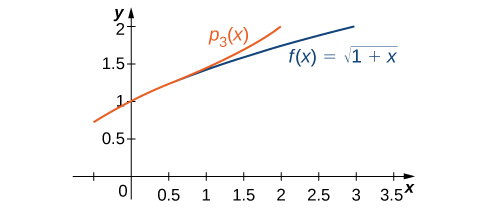
Find the binomial series for
Hint
Use the definition of binomial series for
Common Functions Expressed as Taylor Series
At this point, we have derived Maclaurin series for exponential, trigonometric, and logarithmic functions, as well as functions of the form
In [link], we summarize the results of these series. We remark that the convergence of the Maclaurin series for
at the endpoint
and the Maclaurin series for
at the endpoints
and
relies on a more advanced theorem than we present here. (Refer to Abel’s theorem for a discussion of this more technical point.)
Maclaurin Series for Common Functions
| Function |
Maclaurin Series |
Interval of Convergence |
|
|
|
|
|
|
|
|
|
|
|
|
|
|
|
|
|
|
|
|
|
Earlier in the chapter, we showed how you could combine power series to create new power series. Here we use these properties, combined with the Maclaurin series in [link], to create Maclaurin series for other functions.
Deriving Maclaurin Series from Known Series
Find the Maclaurin series of each of the following functions by using one of the series listed in [link].
-
-
- Using the Maclaurin series for
we find that the Maclaurin series for
is given by
This series converges to
for all
in the domain of
that is, for all
- To find the Maclaurin series for
we use the fact that
Using the Maclaurin series for
we see that the
term in the Maclaurin series for
is given by
For
even, this term is zero. For
odd, this term is
Therefore, the Maclaurin series for
has only odd-order terms and is given by
Find the Maclaurin series for
Hint
Use the Maclaurin series for
We also showed previously in this chapter how power series can be differentiated term by term to create a new power series. In [link], we differentiate the binomial series for
term by term to find the binomial series for
Note that we could construct the binomial series for
directly from the definition, but differentiating the binomial series for
is an easier calculation.
Differentiating a Series to Find a New Series
Use the binomial series for
to find the binomial series for
The two functions are related by
so the binomial series for
is given by
Find the binomial series for
Hint
Differentiate the series for
In this example, we differentiated a known Taylor series to construct a Taylor series for another function. The ability to differentiate power series term by term makes them a powerful tool for solving differential equations. We now show how this is accomplished.
Solving Differential Equations with Power Series
Consider the differential equation
Recall that this is a first-order separable equation and its solution is
This equation is easily solved using techniques discussed earlier in the text. For most differential equations, however, we do not yet have analytical tools to solve them. Power series are an extremely useful tool for solving many types of differential equations. In this technique, we look for a solution of the form
and determine what the coefficients would need to be. In the next example, we consider an initial-value problem involving
to illustrate the technique.
Power Series Solution of a Differential Equation
Use power series to solve the initial-value problem
Suppose that there exists a power series solution
Differentiating this series term by term, we obtain
If y satisfies the differential equation, then
Using [link] on the uniqueness of power series representations, we know that these series can only be equal if their coefficients are equal. Therefore,
Using the initial condition
combined with the power series representation
we find that
We are now ready to solve for the rest of the coefficients. Using the fact that
we have
Therefore,
You might recognize
as the Taylor series for
Therefore, the solution is
Use power series to solve
Hint
The equations for the first several coefficients
will satisfy
In general, for all
We now consider an example involving a differential equation that we cannot solve using previously discussed methods. This differential equation
is known as Airy’s equation. It has many applications in mathematical physics, such as modeling the diffraction of light. Here we show how to solve it using power series.
Power Series Solution of Airy’s Equation
Use power series to solve
with the initial conditions
and
We look for a solution of the form
Differentiating this function term by term, we obtain
If y satisfies the equation
then
Using [link] on the uniqueness of power series representations, we know that coefficients of the same degree must be equal. Therefore,
More generally, for
we have
In fact, all coefficients can be written in terms of
and
To see this, first note that
Then
For
we see that
Therefore, the series solution of the differential equation is given by
The initial condition
implies
Differentiating this series term by term and using the fact that
we conclude that
Therefore, the solution of this initial-value problem is
Use power series to solve
with the initial condition
and
Hint
The coefficients satisfy
and for
Evaluating Nonelementary Integrals
Solving differential equations is one common application of power series. We now turn to a second application. We show how power series can be used to evaluate integrals involving functions whose antiderivatives cannot be expressed using elementary functions.
One integral that arises often in applications in probability theory is
Unfortunately, the antiderivative of the integrand
is not an elementary function. By elementary function, we mean a function that can be written using a finite number of algebraic combinations or compositions of exponential, logarithmic, trigonometric, or power functions. We remark that the term “elementary function” is not synonymous with noncomplicated function. For example, the function
is an elementary function, although not a particularly simple-looking function. Any integral of the form
where the antiderivative of
cannot be written as an elementary function is considered a nonelementary integral.
Nonelementary integrals cannot be evaluated using the basic integration techniques discussed earlier. One way to evaluate such integrals is by expressing the integrand as a power series and integrating term by term. We demonstrate this technique by considering
Using Taylor Series to Evaluate a Definite Integral
- Express
as an infinite series.
- Evaluate
to within an error of
- The Maclaurin series for
is given by
Therefore,
- Using the result from part a. we have
The sum of the first four terms is approximately
By the alternating series test, this estimate is accurate to within an error of less than
Express
as an infinite series. Evaluate
to within an error of
The definite integral is approximately
to within an error of
Hint
Use the series found in [link].
As mentioned above, the integral
arises often in probability theory. Specifically, it is used when studying data sets that are normally distributed, meaning the data values lie under a bell-shaped curve. For example, if a set of data values is normally distributed with mean
and standard deviation
then the probability that a randomly chosen value lies between
and
is given by
(See [link].)
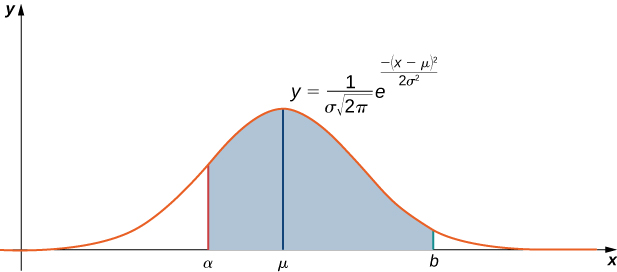
To simplify this integral, we typically let
This quantity
is known as the
score of a data value. With this simplification, integral [link] becomes
In [link], we show how we can use this integral in calculating probabilities.
Using Maclaurin Series to Approximate a Probability
Suppose a set of standardized test scores are normally distributed with mean
and standard deviation
Use [link] and the first six terms in the Maclaurin series for
to approximate the probability that a randomly selected test score is between
and
Use the alternating series test to determine how accurate your approximation is.
Since
and we are trying to determine the area under the curve from
to
integral [link] becomes
The Maclaurin series for
is given by
Therefore,
Using the first five terms, we estimate that the probability is approximately
By the alternating series test, we see that this estimate is accurate to within
Analysis
If you are familiar with probability theory, you may know that the probability that a data value is within two standard deviations of the mean is approximately
Here we calculated the probability that a data value is between the mean and two standard deviations above the mean, so the estimate should be around
The estimate, combined with the bound on the accuracy, falls within this range.
Use the first five terms of the Maclaurin series for
to estimate the probability that a randomly selected test score is between
and
Use the alternating series test to determine the accuracy of this estimate.
The estimate is approximately
This estimate is accurate to within
Hint
Evaluate
using the first five terms of the Maclaurin series for
Another application in which a nonelementary integral arises involves the period of a pendulum. The integral is
An integral of this form is known as an elliptic integral of the first kind. Elliptic integrals originally arose when trying to calculate the arc length of an ellipse. We now show how to use power series to approximate this integral.
Period of a Pendulum
The period of a pendulum is the time it takes for a pendulum to make one complete back-and-forth swing. For a pendulum with length
that makes a maximum angle
with the vertical, its period
is given by
where
is the acceleration due to gravity and
(see [link]). (We note that this formula for the period arises from a non-linearized model of a pendulum. In some cases, for simplification, a linearized model is used and
is approximated by
Use the binomial series
to estimate the period of this pendulum. Specifically, approximate the period of the pendulum if
- you use only the first term in the binomial series, and
- you use the first two terms in the binomial series.
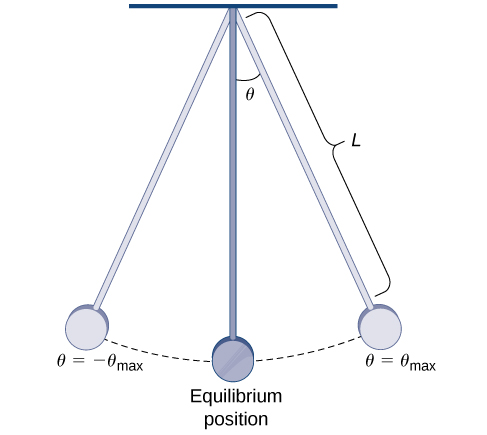
We use the binomial series, replacing
with
Then we can write the period as
- Using just the first term in the integrand, the first-order estimate is
If
is small, then
is small. We claim that when
is small, this is a good estimate. To justify this claim, consider
Since
this integral is bounded by
Furthermore, it can be shown that each coefficient on the right-hand side is less than
and, therefore, that this expression is bounded by
which is small for
small.
- For larger values of
we can approximate
by using more terms in the integrand. By using the first two terms in the integral, we arrive at the estimate
The applications of Taylor series in this section are intended to highlight their importance. In general, Taylor series are useful because they allow us to represent known functions using polynomials, thus providing us a tool for approximating function values and estimating complicated integrals. In addition, they allow us to define new functions as power series, thus providing us with a powerful tool for solving differential equations.
Key Concepts
- The binomial series is the Maclaurin series for
It converges for
- Taylor series for functions can often be derived by algebraic operations with a known Taylor series or by differentiating or integrating a known Taylor series.
- Power series can be used to solve differential equations.
- Taylor series can be used to help approximate integrals that cannot be evaluated by other means.
In the following exercises, use appropriate substitutions to write down the Maclaurin series for the given binomial.
In the following exercises, use the substitution
in the binomial expansion to find the Taylor series of each function with the given center.
at
(Hint:
so
so
In the following exercises, use the binomial theorem to estimate each number, computing enough terms to obtain an estimate accurate to an error of at most
[T]
using
[T]
using
Using, for example, a fourth-degree estimate at
gives
whereas
Two terms would suffice for three-digit accuracy.
In the following exercises, use the binomial approximation
for
to approximate each number. Compare this value to the value given by a scientific calculator.
[T]
using
in
[T]
using
in
The approximation is
the CAS value is
[T]
using
in
[T]
using
in
The approximation is
the CAS value is
Integrate the binomial approximation of
to find an approximation of
[T] Recall that the graph of
is an upper semicircle of radius
Integrate the binomial approximation of
up to order
from
to
to estimate
Thus
whereas
In the following exercises, use the expansion
to write the first five terms (not necessarily a quartic polynomial) of each expression.
Use
with
to approximate
Use the approximation
for
to approximate
Twice the approximation is
whereas
Find the
derivative of
at
Find the
th derivative of
In the following exercises, find the Maclaurin series of each function.
For
using the identity
using the identity
In the following exercises, find the Maclaurin series of
by integrating the Maclaurin series of
term by term. If
is not strictly defined at zero, you may substitute the value of the Maclaurin series at zero.
In the following exercises, compute at least the first three nonzero terms (not necessarily a quadratic polynomial) of the Maclaurin series of
(see expansion for
Using the expansion for
gives
In the following exercises, find the radius of convergence of the Maclaurin series of each function.
so
by the ratio test.
so
by the ratio test.
Find the Maclaurin series of
Find the Maclaurin series of
Add series of
and
term by term. Odd terms cancel and
Differentiate term by term the Maclaurin series of
and compare the result with the Maclaurin series of
[T] Let
and
denote the respective Maclaurin polynomials of degree
of
and degree
of
Plot the errors
for
and compare them to
on
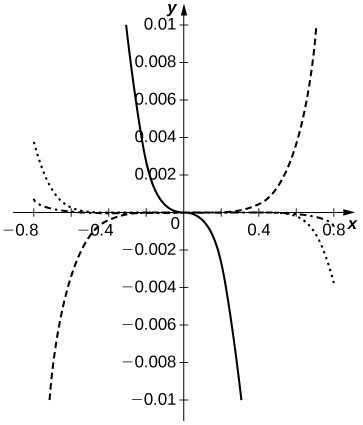
The ratio
approximates
better than does
for
The dashed curves are
for
The dotted curve corresponds to
and the dash-dotted curve corresponds to
The solid curve is
Use the identity
to find the power series expansion of
at
(Hint: Integrate the Maclaurin series of
term by term.)
If
find the power series expansions of
and
By the term-by-term differentiation theorem,
so
whereas
so
[T] Suppose that
satisfies
and
Show that
for all
and that
Plot the partial sum
of
on the interval
[T] Suppose that a set of standardized test scores is normally distributed with mean
and standard deviation
Set up an integral that represents the probability that a test score will be between
and
and use the integral of the degree
Maclaurin polynomial of
to estimate this probability.
The probability is
where
and
that is,
[T] Suppose that a set of standardized test scores is normally distributed with mean
and standard deviation
Set up an integral that represents the probability that a test score will be between
and
and use the integral of the degree
Maclaurin polynomial of
to estimate this probability.
[T] Suppose that
converges to a function
such that
and
Find a formula for
and plot the partial sum
for
on
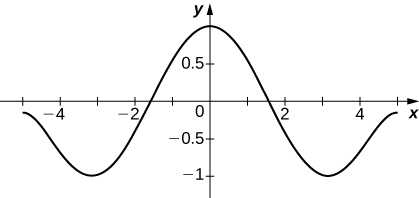
As in the previous problem one obtains
if
is odd and
if
is even, so
leads to
[T] Suppose that
converges to a function
such that
and
Find a formula for
and plot the partial sum
for
on
Suppose that
converges to a function
such that
where
and
Find a formula that relates
and
and compute
and
so
implies that
or
for all
and
so
and
Suppose that
converges to a function
such that
where
and
Find a formula that relates
and
and compute
The error in approximating the integral
by that of a Taylor approximation
is at most
In the following exercises, the Taylor remainder estimate
guarantees that the integral of the Taylor polynomial of the given order approximates the integral of
with an error less than
- Evaluate the integral of the appropriate Taylor polynomial and verify that it approximates the CAS value with an error less than
- Compare the accuracy of the polynomial integral estimate with the remainder estimate.
[T]
(You may assume that the absolute value of the ninth derivative of
is bounded by
a. (Proof) b. We have
We have
whereas
so the actual error is approximately
[T]
(You may assume that the absolute value of the
derivative of
is less than
The following exercises deal with Fresnel integrals.
The Fresnel integrals are defined by
and
Compute the power series of
and
and plot the sums
and
of the first
nonzero terms on
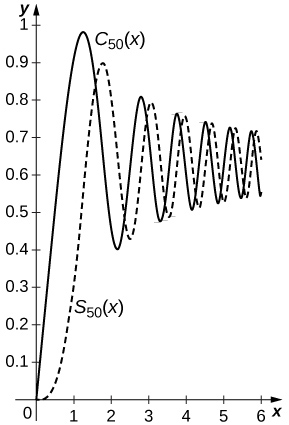
Since
and
one has
and
The sums of the first
nonzero terms are plotted below with
the solid curve and
the dashed curve.
[T] The Fresnel integrals are used in design applications for roadways and railways and other applications because of the curvature properties of the curve with coordinates
Plot the curve
for
the coordinates of which were computed in the previous exercise.
Estimate
by approximating
using the binomial approximation
whereas
[T] Use Newton’s approximation of the binomial
to approximate
as follows. The circle centered at
with radius
has upper semicircle
The sector of this circle bounded by the
-axis between
and
and by the line joining
corresponds to
of the circle and has area
This sector is the union of a right triangle with height
and base
and the region below the graph between
and
To find the area of this region you can write
and integrate term by term. Use this approach with the binomial approximation from the previous exercise to estimate
Use the approximation
to approximate the period of a pendulum having length
meters and maximum angle
where
Compare this with the small angle estimate
seconds. The small angle estimate is
The relative error is around
percent.
Suppose that a pendulum is to have a period of
seconds and a maximum angle of
Use
to approximate the desired length of the pendulum. What length is predicted by the small angle estimate
Evaluate
in the approximation
to obtain an improved estimate for
Hence
[T] An equivalent formula for the period of a pendulum with amplitude
is
where
is the pendulum length and
is the gravitational acceleration constant. When
we get
Integrate this approximation to estimate
in terms of
and
Assuming
meters per second squared, find an approximate length
such that
seconds.
Chapter Review Exercises
True or False? In the following exercises, justify your answer with a proof or a counterexample.
If the radius of convergence for a power series
is
then the radius of convergence for the series
is also
Power series can be used to show that the derivative of
(Hint: Recall that
For small values of
The radius of convergence for the Maclaurin series of
is
In the following exercises, find the radius of convergence and the interval of convergence for the given series.
In the following exercises, find the power series representation for the given function. Determine the radius of convergence and the interval of convergence for that series.
ROC:
IOC:
In the following exercises, find the power series for the given function using term-by-term differentiation or integration.
integration:
In the following exercises, evaluate the Taylor series expansion of degree four for the given function at the specified point. What is the error in the approximation?
exact
In the following exercises, find the Maclaurin series for the given function.
In the following exercises, find the Taylor series at the given value.
In the following exercises, find the Maclaurin series for the given function.
In the following exercises, find the Maclaurin series for
by integrating the Maclaurin series of
term by term.
Use power series to prove Euler’s formula:
The following exercises consider problems of annuity payments.
For annuities with a present value of
million, calculate the annual payouts given over
years assuming interest rates of
A lottery winner has an annuity that has a present value of
million. What interest rate would they need to live on perpetual annual payments of
Calculate the necessary present value of an annuity in order to support annual payouts of
given over
years assuming interest rates of
Glossary
- binomial series
- the Maclaurin series for
it is given by
for
- nonelementary integral
- an integral for which the antiderivative of the integrand cannot be expressed as an elementary function

This work is licensed under a Creative Commons Attribution 4.0 International License.
You can also download for free at http://cnx.org/contents/9a1df55a-b167-4736-b5ad-15d996704270@5.1
Attribution:






